
Pogonomyrmex rugosus, the desert harvester ant or rough harvester ant, is a species of harvester ant in the subfamily Myrmicinae which is endemic to the southwestern United States, specifically New Mexico and southern Colorado.

Pseudomyrmex simplex is a species of ant in the family Formicidae.

Pseudomyrmex ejectus is a species of ant in the family Formicidae.

Pogonomyrmex bicolor, the bicolored harvester ant, is a species of harvester ant native to Arizona, Sonora, Chihuahua, and Sinaloa.

Brachymyrmex depilis is a species of Formicine ant native to North America.
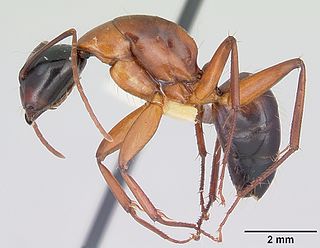
Camponotus texanus is a species of carpenter ant native to Texas, Nuevo Leon, and possibly Arizona.

Camponotus vicinus is a species of carpenter ant widespread throughout western North America; it is found from Alaska, south to Mexico, and east to Texas and Manitoba. Unlike its wood-nesting relatives, C. vicinus is typically found nesting in the soil under stones and other objects.

Camponotus ocreatus is a species of carpenter ant native to northern Mexico and the southwestern United States.

Camponotus semitestaceus is a species of carpenter ant native to the western United States, British Columbia, Baja California, and possibly Veracruz.

Camponotus discolor is a species of carpenter ant native to the eastern United States, North Dakota, Nebraska, Texas, Kansas, Oklahoma, Nuevo Leon, Tamaulipas, and possibly California, Montana, Utah, and Colorado.
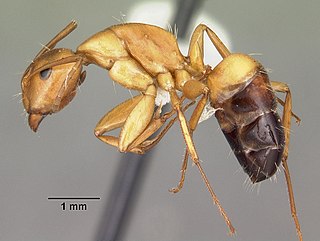
Camponotus snellingi is a species of carpenter ant native to the southeastern United States and possibly Arizona.
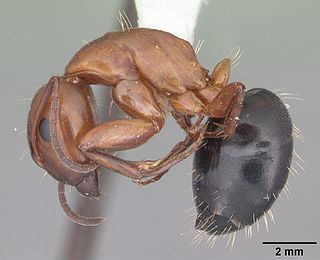
Camponotus decipiens is a species of carpenter ant native to the eastern United States, North Dakota, Nebraska, Kansas, Colorado, Texas, Tamaulipas, Nuevo Leon, San Luis Potosi, and possibly Utah, Arizona, Sonora, and California. The specific epithet of the scientific name, decipiens, comes from Latin "dēcipiens", meaning "decieving, cheating, or trapping".

Camponotus chromaiodes, known generally as, the ferruginous carpenter ant or red carpenter ant, is a species of carpenter ant native to the eastern United States, Nebraska, Kansas, and possibly California. Acetobacteraceae are found in the guts of workers in this species.
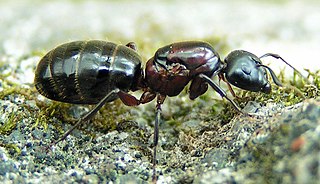
Camponotus novaeboracensis, the New York carpenter ant, is a species of carpenter ant native to the United States, Canada, possibly found in Costa Rica, Malaysia, and invasive in Bermuda.

Pogonomyrmex desertorum, the large seed harvesting ant, is a species of harvester ant native to Mexico, the southwestern United States, and possibly Florida and Colorado.

Gnamptogenys hartmani is a species of ectaheteromorph ant native to South America, Central America, Mexico, Texas, and Louisiana.

Camponotus essigi is a species of carpenter ant native to the western United States, possibly Coahuila, and invasive in Trinidad and Tobago.
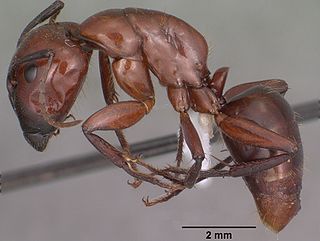
Camponotus schaefferi is a species of carpenter ant native to Arizona, New Mexico, and possibly Venezuela.
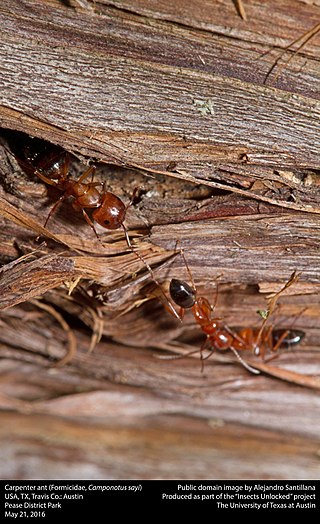
Camponotus sayi is a species of carpenter ant native to the southwest United States, northern Mexico, and possibly North Dakota, Ontario, Mississippi, North Carolina, South Carolina, and Florida.

Camponotus clarithorax is a species of carpenter ant of the subgenus Camponotus native to California, Oregon, the Baja California Peninsula, and possibly the eastern United States. This species is found in Oregon, California, and Baja California.






















